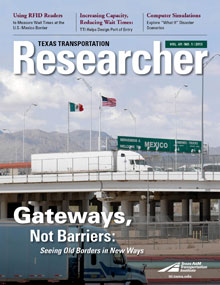As traffic congestion continues to worsen, trip times become more unpredictable. Researchers now have a way to measure that degree of unreliability.
The Planning Time Index (PTI), introduced in the Texas A&M Transportation Institute’s (TTI’s) 2012 Urban Mobility Report (UMR), measures travel reliability, providing a detailed illustration of traffic problems in 498 U.S. urban areas. The PTI illustrates the amount of extra time needed to arrive on time for higher priority events, such as an airline departure, just-in-time shipments, medical appointments or especially important social commitments.

For example, if the PTI for a particular trip is 3.00, a traveler would allow 60 minutes for a trip that typically takes 20 minutes when few cars are on the road. In this case, allowing for a PTI of 3.00 ensures on-time arrival 19 out of 20 times.
PTIs on freeways vary widely across the nation, from 1.31 (about nine extra minutes for a trip that takes 30 minutes in light traffic) in Pensacola, Fla., to 5.72 (almost three hours for that same half-hour trip) in Washington, D.C.
“As bad as traffic jams are, it’s even more frustrating that you can’t depend on traffic jams being consistent from day to day. This unreliable travel is costly for commuters and truck drivers moving goods,” says TTI Senior Research Engineer Bill Eisele, report co-author and manager of TTI’s Mobility Analysis Program.

In addition to the PTI, the 2012 UMR also debuts an estimate of the additional carbon dioxide (CO2) emissions attributed to traffic congestion: 56 billion pounds — about 380 pounds per auto commuter.
“Including CO2 emissions in the UMR provides another dimension to the urban congestion problem,” explains co-author and TTI Associate Research Scientist David Schrank. “It points to the importance of implementing transportation improvements to reduce congestion.”
Researchers say that the most effective way to address traffic congestion varies from one urban area to another. In all cases, improving mobility requires a multifaceted approach that includes more efficient traffic management and public transportation combined with new construction. Travel options such as flexible work hours and telecommuting should also be part of the solution.
The current study includes 30 years of trend data TTI has used to measure and analyze traffic congestion and its impact on life in urban America. The report is the third prepared in partnership with INRIX, a leading private-sector provider of travel-time information for both commuters and shippers.



